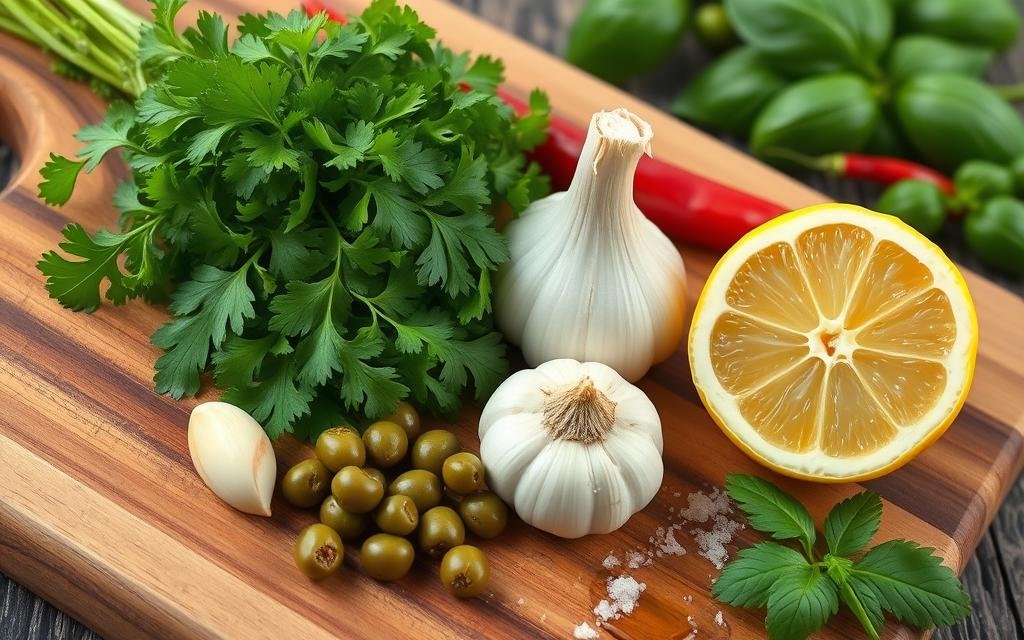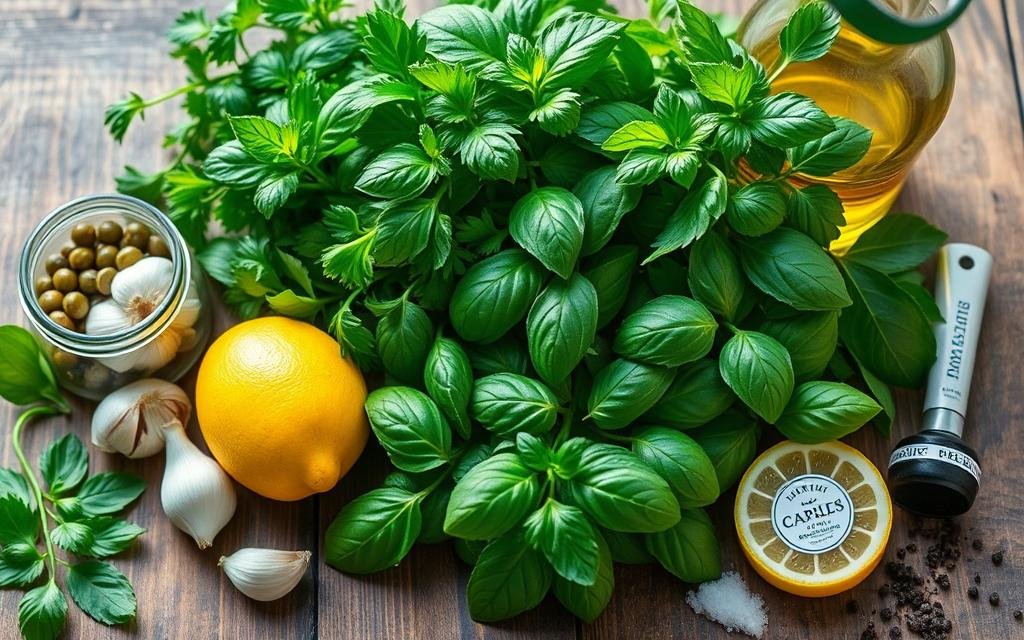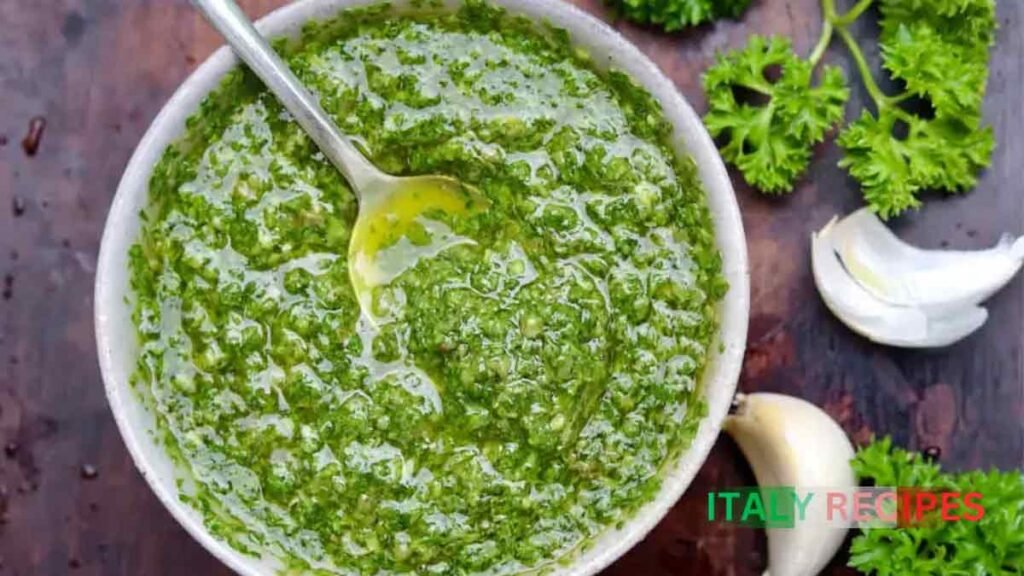The aroma of fresh herbs fills the air as you chop parsley, basil, and mint. Your senses come alive, taking you to Italy’s sunny hillsides. This is the magic of making authentic Italian salsa verde – a vibrant sauce that captures the essence of Mediterranean cuisine.
Making the perfect Italian salsa verde recipe is an art. This versatile, herb-based sauce can make any dish special. Whether you’re a seasoned chef or just starting, learning this classic sauce will unlock new culinary possibilities.
In this guide, we’ll show you how to make an authentic Italian salsa verde. You’ll learn how to balance flavors, pick the freshest ingredients, and use expert techniques. By the end, you’ll be able to impress your family and friends with this delicious Italian staple.
Introduction to Italian Salsa Verde
Italian salsa verde is a vibrant, herbaceous sauce that adds a burst of flavor to many dishes. It’s a staple in Italian cuisine, known for its fresh taste and versatility. Let’s explore the essence of this delightful condiment and its rich cultural heritage.
What is Italian Salsa Verde?
Italian salsa verde is a cold sauce made from finely chopped herbs, capers, anchovies, garlic, and olive oil. The ingredients create a perfect balance of tangy, salty, and aromatic flavors. It’s often used as a dip, spread, or accompaniment to various dishes.
Origins and Cultural Significance
The roots of Italian salsa verde can be traced back to medieval times. It gained popularity as a way to enhance and preserve foods. Today, it remains an integral part of Italian culinary tradition, gracing tables from rustic countryside kitchens to upscale urban restaurants.

Key Differences from Mexican Salsa Verde
While both are green sauces, Italian and Mexican salsa verde differ significantly. The Italian version relies on herbs like parsley and uses olive oil as a base. In contrast, Mexican salsa verde features tomatillos and chili peppers, creating a distinctly different flavor profile and consistency.
“Italian salsa verde is like a burst of sunshine in your mouth. It brightens any dish it touches.”
Essential Ingredients for Authentic Italian Salsa Verde
Italian salsa verde is a vibrant and flavorful sauce. It relies on fresh ingredients. The key to creating this delicious condiment lies in selecting high-quality salsa verde ingredients. Let’s explore the essential components that give this sauce its distinctive taste.
Fresh parsley is at the heart of any parsley salsa verde recipe. This herb provides a bright, grassy flavor and vivid green color. Garlic adds a pungent kick, while capers bring a briny tang. Salsa verde with capers offers a delightful contrast to rich meats and fish.
Anchovies might seem unusual, but they’re crucial for depth and umami. Don’t worry – they won’t make your sauce fishy. High-quality extra virgin olive oil forms the base, creating a smooth texture and rich mouthfeel. A splash of vinegar, typically red wine or white wine vinegar, adds necessary acidity.
“The secret to a great salsa verde is balance. Each ingredient plays a crucial role in creating harmony of flavors.”
Some variations include lemon zest for extra brightness or bread crumbs for thickness. Experiment with these salsa verde ingredients to find your perfect blend. Remember, the key is using the freshest ingredients possible for the most authentic taste.
Step-by-Step Italian Salsa Verde Recipe
Making an easy salsa verde recipe is easier than you think. This Italian classic adds fresh flavors to your meals. Let’s explore how to make this tasty sauce step by step.
Preparing the Herbs and Aromatics
Begin by finely chopping fresh parsley, capers, and garlic. Make sure to mince them as small as you can for a smooth texture. Also, finely dice a small onion or shallot for extra depth.

Mixing the Base Ingredients
In a bowl, mix the chopped herbs and aromatics with good olive oil. Add a bit of red wine vinegar for a tangy taste. Blend well to combine the flavors. This is the base of your salsa verde.
Adjusting Flavors and Consistency
Try your salsa verde and adjust it if needed. Add salt and pepper to boost the flavors. If it’s too thick, add a bit more olive oil. For a zesty touch, squeeze some lemon juice. The perfect salsa verde is slightly chunky but spreads easily.
Resting and Serving Tips
Let your Italian salsa verde rest for at least 30 minutes before serving. This lets the flavors mix well. Serve it at room temperature with grilled meats, fish, or crusty bread. Your homemade salsa verde will impress everyone with its vibrant taste and versatility.
Pairing Italian Salsa Verde with Various Dishes
Italian salsa verde is a versatile sauce that enhances many dishes. Its vibrant flavors complement a wide range of ingredients. This makes it a favorite among chefs and home cooks alike.
Salsa Verde for Fish Dishes
Salsa verde for fish is a match made in culinary heaven. The bright, herbal notes of the sauce perfectly balance the delicate flavors of seafood. Try drizzling it over grilled salmon or serving it alongside baked cod.
For a Mediterranean twist, pair salsa verde with a whole roasted sea bass.
Complementing Meat Dishes with Salsa Verde
Salsa verde for meat adds a zesty kick to your favorite proteins. Spoon it over a juicy steak or use it to elevate a simple chicken breast. For a traditional Italian experience, serve salsa verde with bollito misto, a classic mixed boiled meat dish.
The sauce cuts through the richness of the meat, creating a harmonious flavor profile.
Vegetarian Options for Salsa Verde
Vegetarians can enjoy salsa verde too! Toss it with roasted vegetables for a flavorful side dish. It’s particularly delicious with grilled eggplant or zucchini.
For a hearty main course, try serving salsa verde over a bed of creamy polenta or use it as a dipping sauce for crusty bread.
“Salsa verde is the secret weapon in my kitchen. It transforms ordinary dishes into extraordinary meals with just a spoonful.”
Experiment with these pairings to discover your favorite way to enjoy Italian salsa verde. Its versatility makes it a valuable addition to any meal, whether you’re cooking fish, meat, or vegetarian options.
Tips and Tricks from Master Chefs
Italian chefs share their secrets for the perfect salsa verde. Choose fresh, high-quality herbs for this classic sauce. The best parsley gives your salsa its vibrant green color and strong flavor.
For a richer flavor, mix herbs like parsley, basil, or mint. Finely chop them by hand to keep the sauce thick and flavorful.
“The key to a great salsa verde lies in the balance of flavors. Taste as you go and adjust the acidity with lemon juice or vinegar to complement the richness of the olive oil,” advises Chef Maria Rossi, a master of Italian recipes.
Use garlic sparingly to avoid bitterness. Start with a small amount and add more if needed. Raw or lightly sautéed garlic works best.
Try adding capers or anchovies for a unique twist. These ingredients add a delicious umami flavor to your sauce.
Let your salsa verde rest for at least 30 minutes before serving. This allows the flavors to blend, making your sauce even more delicious.
Similar Italian Recipes
Italian cuisine is full of tasty sauces beyond salsa verde. Let’s look at some Italian recipes with fresh herbs and vibrant flavors.
Gremolata is a zesty condiment that brightens many Italian dishes. It’s made from lemon zest, garlic, and parsley. It adds a burst of freshness to osso buco and grilled meats. You can make gremolata at home to make your meals better.
Pesto is another favorite Italian green sauce from Genoa. It uses basil, pine nuts, garlic, Parmesan cheese, and olive oil. It’s great on pasta, sandwiches, or as a dip.
Salsa rossa is a red sauce with sun-dried tomatoes, roasted red peppers, and herbs. It’s perfect with grilled vegetables or crusty bread. It offers a sweet and tangy taste.
“In Italian cooking, it’s all about letting quality ingredients shine. These sauces are no exception – they’re simple yet packed with flavor.”
Trying these Italian recipes will add to your cooking skills. Each sauce has its own special taste. They let you make different and exciting meals inspired by Italian traditions.
Conclusion
Italian salsa verde is a true culinary treasure. It adds a burst of fresh flavors to any dish. Our authentic Italian salsa verde recipe will help you make a versatile condiment.
This sauce is great with fish, meat, and even vegetarian dishes. The secret to a perfect salsa verde is using top-notch ingredients and finding the right balance of flavors. Feel free to tweak the recipe to match your taste. With a bit of practice, you’ll become a pro at making this classic Italian sauce.
Now, it’s time to start making your own Italian salsa verde. This easy yet tasty sauce will soon become a favorite in your kitchen. It adds a special Italian touch to your meals. So, get your herbs ready, sharpen your knife, and let’s make some Italian magic in your home!
FAQ
What is the difference between Italian Salsa Verde and Mexican Salsa Verde?
Italian Salsa Verde is made with parsley, garlic, capers, and anchovies. Mexican Salsa Verde uses tomatillos, jalapeños, onions, and cilantro. Italian Salsa Verde tastes herbaceous and salty. Mexican Salsa Verde is tangy and spicy.
Can I substitute or omit any ingredients in the Italian Salsa Verde recipe?
It’s best to stick to the recipe for the real taste. Capers and anchovies give it a briny flavor. For a vegetarian version, skip the anchovies but keep the capers for that salty taste.
How long does homemade Italian Salsa Verde last?
Homemade Italian Salsa Verde lasts 5-7 days in the fridge. Use fresh ingredients and follow safe food handling.
What dishes pair well with Italian Salsa Verde?
Italian Salsa Verde goes well with many dishes. It’s great with fish, meat, or as a topping for bruschetta. It’s also good as a dip or pasta sauce.
Can I adjust the consistency of the Salsa Verde?
Yes, you can! For a thinner sauce, add more olive oil or vinegar. For thicker, pulse it more or reduce liquid. Adjust to your liking or the dish’s needs.
What are some variations of Italian Salsa Verde?
Try different herbs like basil, cilantro, or arugula. Add lemon zest or juice for brightness. Red pepper flakes can add heat. Experiment with different vinegars like red wine or sherry.




